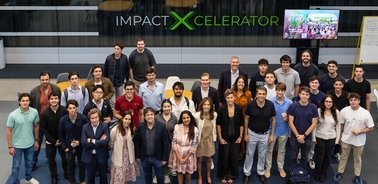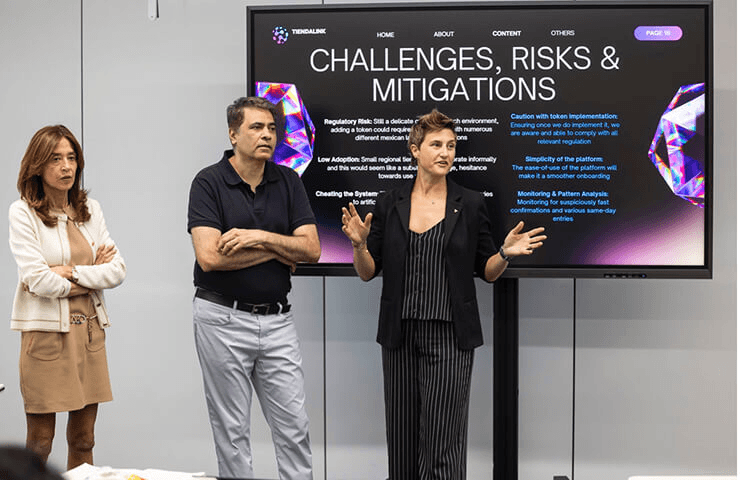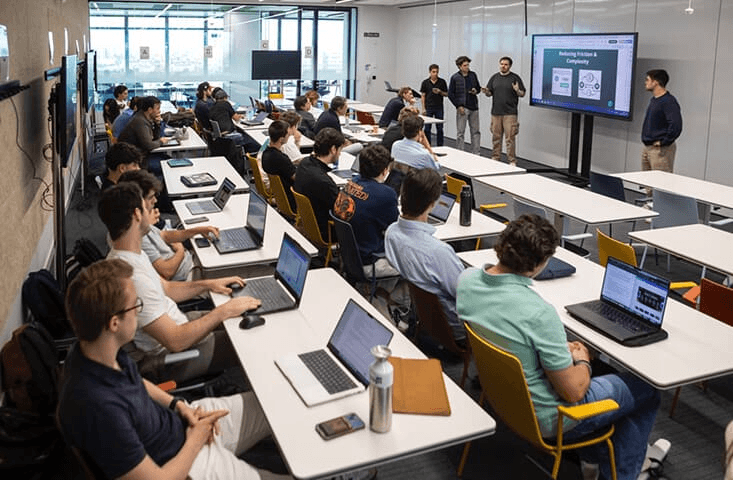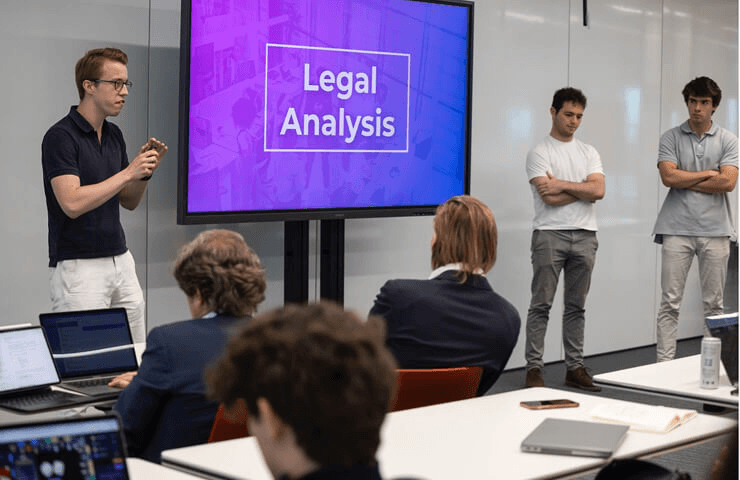Unlocking the Code of Future Finance: Lessons from the Fintech, Blockchain XRP and Policy Gateway Program

IE Sci-Tech’s Gateway Program trains students at the frontier of blockchain, regulation, and real-world venture building.
This year, IE Sci-Tech launched the Fintech, Blockchain XRP and Policy Gateway Program with the aim of equipping students with the skills and judgment needed to navigate the next era of financial innovation. The program was developed to provide a rigorous, hands-on exploration of blockchain’s technical foundations, economic implications, and regulatory landscape. Supported by Ripple’s University Blockchain Research Initiative (UBRI), it forms a key pillar of the School’s IEX Research Xcelerator Gateway initiative, connecting students with engineering, law, and business through one integrated platform.
Over the course of six months, students immersed themselves in decentralized finance (DeFi), token economics, identity verification, and blockchain infrastructure—all anchored in the XRP Ledger ecosystem. The program culminated in a final showcase at IE Tower in Madrid, where teams presented their blockchain solutions to faculty and guest judge Lauren Weymouth, Ripple’s Senior Director and Global Head of University Partnerships.
From Madrid to Paris: Building in the XRP Ecosystem
As a credit-bearing academic experience (21 sessions, 3 ECTS), the Gateway Program offered more than just lectures. Students from Sci-Tech, Business, and Law collaborated in interdisciplinary teams to explore blockchain’s real-world impact. A central highlight was a three-day immersion at XRPL Commons in Paris, where students trained on the XRP Ledger and engaged with AMM mechanics, order book dynamics, and decentralized governance models. The experience also included simulations and startup collaboration exercises focused on topics like digital identity, token emissions, and regulation-by-design.
According to Sci-Tech Dean Ikhlaq Sidhu, the Paris immersion was "a key inflection point" that shaped how students approached their final projects.
Watch highlights from the XRPL Commons Study Trip to see students in action alongside blockchain developers and ecosystem leaders.
“We didn’t want this to be only theory. You had to build something—but then also add the business and policy perspective. This is not just an academic exercise—it is a crash course in how blockchain actually works, from technology to business to policy.” Ikhlaq Sidhu, Dean of IE Sci-Tech.
Sidhu added, "Blockchain doesn’t live neatly within any one academic discipline. You can come from computer science or finance—but neither teaches you what it means to build responsibly in this space. That’s what this program tried to achieve."
 Designing with Friction: Policy as a Starting Point
Designing with Friction: Policy as a Starting Point
A defining feature of the program was its deep integration of regulatory fluency into the learning process. Students were challenged to grapple with live issues: from token classification and AML frameworks to GDPR, infrastructure scalability, and central bank digital currencies (CBDCs). Legal ambiguity, governance trade-offs, and compliance hurdles weren’t a backdrop; they were the design constraints.
Lauren Weymouth, who flew in from San Francisco to observe the final pitches, explained the purpose behind Ripple’s academic initiative: "We launched UBRI to accelerate blockchain education—but more importantly, to support students who want to build in this space, not just write about it. IE’s approach stood out because it fused policy, design, and development in one loop."
“The kinds of ideas I saw presented here are the same conversations we’re having with regulators, founders, and developers around the world—including at APEX in Singapore, where the XRP Ledger ecosystem comes together.” Lauren Weymouth, Senior Director and Global head of University Partnerships, UBRI.
From Challenge to Prototype
The Gateway Program required each student team to develop a blockchain-based solution that was technically feasible, legally viable, and socially meaningful. Among the standout projects:
• OrganizeNow – A digital invoice tokenization platform to improve liquidity access for SMEs in Latin America.
"Too many small businesses are locked out of liquidity," said Laura. "We’re opening a door to cash flow in 48 hours instead of 60 days."
• Verifi – A decentralized KYC credential system that allows users to store and reuse verified identity data securely.
"Why should KYC take 90 days and endless forms?" asked Arjun. "We want a system where users control their data and reuse it securely anywhere."
• TandaLink – A blockchain tool for small corner stores in Mexico to log inventory deliveries, reduce disputes, and build verifiable credit records.
"My grandmother ran a tienda with handwritten ledgers," said Diego. "We’re not trying to turn them into fintech wizards—we’re just giving them a record, a way into the system."
Each project was evaluated by Gateway faculty—Professors Alexandr Chevtaev, Andrew Whitworth, Eduardo Castello, and Luis Maldonado—on legal structure, smart contract architecture, compliance, and infrastructure viability.
Blockchain, Built for Scale
What made the program impactful wasn’t just the build phase. It was the demand for regulatory literacy, user-centered thinking, and blockchain network fluency from day one. Students had to map out real risks, address compliance pathways, and argue for sustainability beyond technical novelty.
"Normally in venture pitches, the legal stuff is hand-waved," said Sidhu. "Here, it was front and center."
For many, the Gateway marked a shift; from seeing blockchain as a software tool, to understanding it as a set of interlocking systems: economic, legal, technological, and social.
Global Stage: APEX Singapore
After the final review, three students—Antonio Meneses Escalante, Martin Gutierrez Olarte, and Vansh Bijlani—were selected to attend the UBRI Connect and APEX Summit in Singapore, one of the XRP Ledger community’s most influential gatherings. While in Singapore, they will also participate in the global XRPL hackathon, working alongside developers, policy thinkers, and founders from around the world.
Leticia Cabral Calvillo, Director of Business Development and Operations at the IEX Impact Xcelerator, congratulated the students: "We looked at everything—engagement, initiative, the ability to collaborate. This wasn’t an easy decision given the caliber of students."
Beyond the Gateway
Cabral Calvillo emphasized the importance of designing a curriculum that balanced technical learning with real-world application.
“This first edition of the Fintech, Blockchain, XRP and Policy Gateway Program was a blueprint for how blockchain should be taught—not as a siloed tech vertical, but as an integrated system. It’s about building infrastructure for the future of finance, where protocols aren’t just engineered, they’re governed, regulated, and designed for impact. That’s exactly what students looking to enter fields like fintech entrepreneurship, digital assets, or crypto compliance will need to succeed.” Leticia Cabral Calvillo, IEX Director of Business Development and Operations.
A huge congratulations to Antonio Meneses Escalante, Martin Gutierrez Olarte, and Vansh Bijlani, who will be heading from the whiteboards of Madrid Tower, through the XRP Commons in Paris, and now to Singapore, representing IE Sci-Tech on a global stage.

